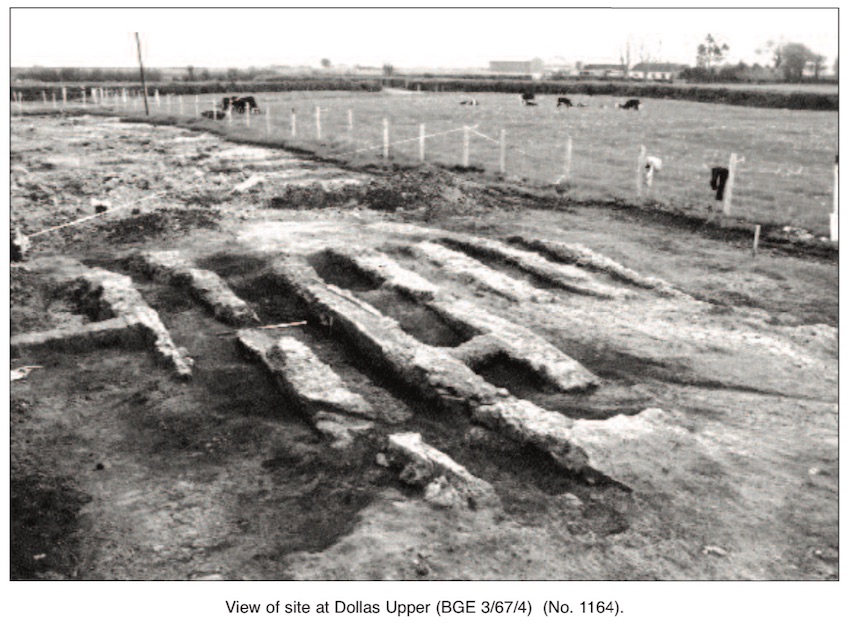2002:1164 - DOLLAS UPPER (BGE 3/67/4), Limerick
County: Limerick
Site name: DOLLAS UPPER (BGE 3/67/4)
Sites and Monuments Record No.: N/A
Licence number: 02E0557
Author: Graham Hull, Margaret Gowen & Co. Ltd.
Site type: Kiln -brick
Period/Dating: Post Medieval (AD 1600-AD 1750)
ITM: E 548918m, N 639185m
Latitude, Longitude (decimal degrees): 52.501670, -8.752362
This site was examined as part of Bord Gáis Éireann’s Pipeline to the West. The excavated area measured c. 8m south-east/north-west by c. 12m and was situated on flat pasture, with bog to the immediate east.
Seven parallel rows of bricks were observed, oriented north-west/south-east. This structural group had a combined measurement of c. 7m by c. 9m. It was likely that a degree of machine truncation of these features had occurred during topsoil-stripping. The individual rows were 0.42–0.46m wide and 0.6–0.7m apart. The rows of bricks survived to 0.25–0.3m high and, in places, had three courses of brickwork.
The bricks were both brown and red and were clearly handmade and unfrogged. The bricks typically measured 240mm by 100mm by 70mm (91/2in by 4in by 23/4in). They were poorly fired, unmortared and laid alternately header then stretcher.
At the north-west of the structure, in particular, the natural clay had been oxidised red by heating.
Loose bricks were found between the rows. This rubble overlay a very charcoal-rich deposit that was confined to the space between the rows. The charcoal was 0.02–0.09m thick.
Four iron artefacts were recovered from the demolition/levelling deposits overlying the brick structure: a horseshoe, a nail, a handle and an unidentified object.
The excavated remains represented a brick clamp, probably of post-medieval date.
A brick clamp (or temporary kiln) is a rectangular construction for firing bricks. The ‘green’ bricks were stacked on the ground in rows (‘benches’), and alternate header and stretcher layers were built up to form an externally battered structure. The gaps between the lower rows of bricks were filled with fuel (in this case probably peat) and ignited. These gaps would have facilitated a through draught. The clamp was most likely covered with turf, and the slow firing of the bricks would have generated large amounts of white smoke. The clamp would have burned for a number of days before the finished bricks could be taken down, ready for use. An average-sized clamp (such as that excavated) might have been stacked up to 5m high and produced 20,000 to 30,000 bricks (Dobson 1850; Goldthwaite 1980; Drury 1981; Palmer and Neaverson 1998; Rynne 1999).
The post-medieval production of brick increased because of shortages of structural timbers (Palmer and Neaverson 1998, 44), and the simple and intermittent form of clamp recorded at Dollas Upper may pre-date the mechanised production of bricks in the mid-19th century. However, during the late 18th and early 19th century, and even into the 20th century, brick making was a seasonal activity (Rynne 1999). Therefore, the production of locally consumed bricks may have taken place at the excavated site until relatively recently.
The size of the bricks may assist in defining the site chronology, by reference to various Brick Acts, but it is not unreasonable to assume that an unregulated ‘home industry’ may have paid scant heed to distant decrees. Examination and comparison with brickwork in nearby, dated buildings might therefore be useful, as a clamp was generally built to provide bricks for a single project (Dobson 1850). Donald Murphy (Excavations 1998, No. 263, 98E0386) excavated a similar brick clamp at Portumna that has been dated by comparison with 17th-century bricks from a nearby castle.
Fired-clay pellets, which may indicate brick production, were observed on the stripped ground surface of the pipeline, spread within a few kilometres of the excavated site. This may indicate that more than one brick-production centre operated in the vicinity. This said, the deposits of fired clay may have resulted from stubble burning when the agriculture in the vicinity changed briefly from pasture to arable during World War Two (M. Gowen, pers. comm.).
References
Dobson, E. 1850 A rudimentary treatise on the manufacture of brick and tiles. London. [Reprinted Journal of Ceramic History 5 (1971).]
Drury, P.J. 1981 The production of brick and tile in medieval England. In D.W. Crossley (ed.), Medieval industry, 126–42. CBA Research Report 40. London.
Goldthwaite, R. 1980 The building of Renaissance Florence: an economic and social history. Baltimore.
Palmer, M. and Neaverson, P. 1998 Industrial archaeology: principles and practice. London.
Rynne, C. 1999 The industrial archaeology of Cork city and its environs. Dublin.

